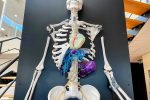Cape to Cairo: the making and unmaking of colonial road networks
In 2024, Egypt completed its 1,155km stretch of the Cairo–Cape Town Highway, a 10,228km‑long road connecting 10 African countries – Egypt, Sudan, South Sudan, Ethiopia, Kenya, Tanzania, Zambia, Zimbabwe, Botswana and South Africa.
The imaginary of ‘Cape to Cairo’ is not new. In 1874, editor of the Daily Telegraph Edwin Arnold proposed a plan to connect the African continent by rail, a project that came to be known as the Cape to Cairo Railway project. Cecil Rhodes expressed his support for the project, seeing it as a means to connect the various ‘possessions’ of the British Empire across Africa, facilitating the movement of troops and natural resources. This railway project was never completed, and in 1970 was overlaid by a very different attempt at connecting the Cape to Cairo, as part of the Trans‑African Highway network. This 56,683km‑long system of highways – some dating from the colonial era, some built as part of the 1970s project, and some only recently built – aimed to create lines of connection across the African continent, from north to south as well as east to west.
Here, postcolonial state power invested in ‘moving the continent’s people and economies from past to future’, as architectural historians Kenny Cupers and Prita Meier write in their 2020 essay ‘Infrastructure between Statehood and Selfhood: The Trans‑African Highway’. The highways were to be built with the support of Kenya’s president Jomo Kenyatta, Ghana’s president Kwame Nkrumah and Ghana’s director of social welfare Robert Gardiner, as well as the United Nations Economic Commission for Africa. This project was part of a particular historical moment during which anticolonial ideas animated most of the African continent; alongside trade, this iteration of Cape to Cairo centred social and cultural connection between African peoples. But though largely socialist in ambition, the project nevertheless engaged modernist developmentalist logics that cemented capitalism.
Lead image: Over a century in the making, the final stretches of the Cairo–Cape Town Highway are being finished. Egypt completed the section within its borders last year and a section over the dry Merille River in Kenya was constructed in 2019. Credit: Allan Muturi / SOPA / ZUMA / Alamy. Above: The route from Cairo to Cape Town, outlined in red, belongs to the Trans‑African Highway network, which comprises nine routes, here in black
The project failed to fully materialise at the time, but efforts to complete the Trans‑African Highway network have been revived in the last 20 years; large parts are now complete though some links remain unbuilt and many roads are unpaved or hazardous. The most recent attempts to realise this project coincide with a new continental free trade agreement, the agreement on African Continental Free Trade Area, established in 2019, to increase trade within the continent. The contemporary manifestation of the Cairo–Cape Town Highway – also known as Trans‑African Highway4 – is marked by deepening neoliberal politics. Represented as an opportunity to boost trade and exports, connecting Egypt to African markets that the Egyptian government view as ‘untapped’, the project invokes notions of trade steeped in extraction, reflecting the neoliberal logic underpinning contemporary Egyptian governance; today, the country’s political project, led by Abdel Fattah El Sisi, is oriented towards Egyptian dominance and extraction in relation to the rest of the continent.
Through an allusion to markets ripe for extraction, this language brings to the fore historical forms of domination that have shaped the connections between Egypt and the rest of the continent; previous iterations of connection across the continent often reproduced forms of domination stretching from the north of the African continent to the south, including the Trans‑Saharan slave trade routes across Africa that ended in various North African and Middle Eastern territories. These networks, beginning in the 8th century and lasting until the 20th, produced racialised hierarchies across the continent, shaping North Africa into a comparably privileged space proximate to ‘Arabness’. This was a racialised division based on a civilisational narrative that saw Arabs as superior, but more importantly a political economic division resulting from the slave trade routes that produced huge profits for North Africa and the Middle East. In the contemporary moment, these racialised hierarchies are bound up in political economic dependency on the Arab Gulf states, who are themselves dependent on resource extraction, land grabbing and privatisation across the entire African continent.
‘The Cairo–Cape Town Highway connects Egypt to African markets viewed as “untapped”, invoking notions steeped in extraction’
However, this imaginary conjured by the Cairo–Cape Town Highway is countered by a network of streets scattered across Africa that traces the web of Egyptian Pan‑African solidarity across the continent. In Lusaka in Zambia, you might find yourself on Nasser Road, as you might in Mwanza in Tanzania or Luanda in Angola. In Mombasa in Kenya, you might be driving down Abdel Nasser Road; in Kampala in Uganda, you might find yourself at Nasser Road University; and in Tunis in Tunisia, you might end up on Gamal Abdel Nasser Street. These street names are a reference to Gamal Abdel Nasser, Egypt’s first postcolonial leader and president between 1956 and 1970.
Read against the contemporary Cairo–Cape Town Highway, these place names signal a different form of connection that brings to life Egyptian Pan‑Africanism, when solidarity was the hegemonic force connecting the continent, coming up against the notion of a natural or timeless ‘great divide’ within Africa. From the memoirs of Egyptian officials who were posted around Africa as conduits of solidarity, to the broadcasts of Radio Cairo that were heard across the continent, to the various conferences attended by anticolonial movements and postcolonial states, Egypt’s orientation towards Pan‑Africanism, beginning in the early 20th century and lasting until the 1970s, was both material and ideological. Figures and movements forged webs of solidarity with their African comrades, imagining an Africa that was united through shared commitments to ending colonialism and capitalist extraction.
The route between Cape Town in South Africa and Cairo in Egypt has long occupied the colonial imaginary. In 1930, Margaret Belcher and Ellen Budgell made the journey, sponsored by car brand Morris and oil company Shell
Credit: Fox Photos / Getty
The pair made use of the road built by British colonisers in the 19th century, and which forms the basis for the current Cairo–Cape Town Highway. The road was preceded by the 1874 Cape to Cairo Railway project, which connected the colonies of the British Empire
Credit: Library of Congress, Geography and Map Division
This network of eponymous streets represents attempts to inscribe anticolonial power into the materiality of the city. Street‑naming practices are one way in which the past comes into the present, ‘weaving history into the geographic fabric of everyday life’, as geographer Derek Alderman wrote in his 2002 essay ‘Street Names as Memorial Arenas’. In this vein, the renaming of streets during decolonisation marked a practice of contesting the production of colonial space. In the newly postcolonial city, renaming was a way of ‘claiming the city back’, Alderman continues. While these changes may appear discursive, it is their embedding in material spaces, through signs and maps, that make the names come to life; place names become a part of the everyday through sharing addresses or giving directions. This quality makes them powerful; consciously or unconsciously, they form part of how the spaces of the city are navigated.
These are traces that were once part of a dominant historical narrative; yet when they are encountered in the present, during a different historical moment, they no longer act as expressions of power but instead conjure up a moment that has long passed. A street in Lusaka named after an Egyptian general made more sense 60 years ago than it does today, yet contextualising it recovers a marginalised history of Egyptian Pan‑Africanism.
Markers such as street names or monuments are simultaneously markers of anticolonial struggle as well as expressions of state power – part of an attempt, by political projects such as Nasser’s, to exert their own dominance over cities, towns and villages. That such traces are expressions of both anticolonial hopes and postcolonial state power produces a sense of tension within them. For instance, Nasser’s postcolonial project in Egypt was a contradictory one; it gave life to anticolonial hopes – for instance by breaking away from European capitalism and embracing anticolonial geopolitics – while crushing many parts of the left through repression, censorship and imprisonment. Traces of Nasser found today inscribe both anticolonial promises – those that came to life and those that did not – while reproducing postcolonial power that in most instances ended in dictatorship.
Recent efforts to complete the route build on those of the post‑independence era – work on a section north of Nairobi started in 1968
Credit: Associated Press / Alamy
The Trans‑African Highway network was conceived in 1970 in the spirit of Pan‑Africanism
At that time, the routes did not extend into South Africa, which was in the grip of apartheid. The Trans‑African Highway initiative was motivated by a desire to improve trade and centre cultural links across the continent – an ambition that was even celebrated on postage stamps
There have been long‑standing debates about the erasure of the radical anticolonial spirit from the more conservative postcolonial states that emerged; the promises and hopes of anticolonialism, not least among them socialism and a world free of white supremacy, remain largely unrealised. Instead, by the 1970s neoliberalism emerged as a new hegemonic project. The contemporary instantiation of Cape to Cairo highlights just how pervasive neoliberal logics continue to be, despite multiple global financial crises and the 2011 Egyptian revolution demanding ‘bread, freedom, social justice’.
But the network of streets named after anticolonial figures and events across the world is testament to the immense power and promise of anticolonial revolution. Most of the 20th century was characterised by anticolonial struggle, decolonisation and postcolonial nation‑building, as nations across the global south gained independence from European empire and founded their own political projects. Anticolonial traces, present in street and place names, point to the possibility of solidarity as a means of reorienting colonial geographies. They are a reminder that there have been other imaginings of Cape to Cairo, and that things can be – and have been – otherwise.
2025-06-13
Kristina Rapacki
Share
#cape #cairo #making #unmaking #colonial
Cape to Cairo: the making and unmaking of colonial road networks
In 2024, Egypt completed its 1,155km stretch of the Cairo–Cape Town Highway, a 10,228km‑long road connecting 10 African countries – Egypt, Sudan, South Sudan, Ethiopia, Kenya, Tanzania, Zambia, Zimbabwe, Botswana and South Africa.
The imaginary of ‘Cape to Cairo’ is not new. In 1874, editor of the Daily Telegraph Edwin Arnold proposed a plan to connect the African continent by rail, a project that came to be known as the Cape to Cairo Railway project. Cecil Rhodes expressed his support for the project, seeing it as a means to connect the various ‘possessions’ of the British Empire across Africa, facilitating the movement of troops and natural resources. This railway project was never completed, and in 1970 was overlaid by a very different attempt at connecting the Cape to Cairo, as part of the Trans‑African Highway network. This 56,683km‑long system of highways – some dating from the colonial era, some built as part of the 1970s project, and some only recently built – aimed to create lines of connection across the African continent, from north to south as well as east to west.
Here, postcolonial state power invested in ‘moving the continent’s people and economies from past to future’, as architectural historians Kenny Cupers and Prita Meier write in their 2020 essay ‘Infrastructure between Statehood and Selfhood: The Trans‑African Highway’. The highways were to be built with the support of Kenya’s president Jomo Kenyatta, Ghana’s president Kwame Nkrumah and Ghana’s director of social welfare Robert Gardiner, as well as the United Nations Economic Commission for Africa. This project was part of a particular historical moment during which anticolonial ideas animated most of the African continent; alongside trade, this iteration of Cape to Cairo centred social and cultural connection between African peoples. But though largely socialist in ambition, the project nevertheless engaged modernist developmentalist logics that cemented capitalism.
Lead image: Over a century in the making, the final stretches of the Cairo–Cape Town Highway are being finished. Egypt completed the section within its borders last year and a section over the dry Merille River in Kenya was constructed in 2019. Credit: Allan Muturi / SOPA / ZUMA / Alamy. Above: The route from Cairo to Cape Town, outlined in red, belongs to the Trans‑African Highway network, which comprises nine routes, here in black
The project failed to fully materialise at the time, but efforts to complete the Trans‑African Highway network have been revived in the last 20 years; large parts are now complete though some links remain unbuilt and many roads are unpaved or hazardous. The most recent attempts to realise this project coincide with a new continental free trade agreement, the agreement on African Continental Free Trade Area, established in 2019, to increase trade within the continent. The contemporary manifestation of the Cairo–Cape Town Highway – also known as Trans‑African Highway4 – is marked by deepening neoliberal politics. Represented as an opportunity to boost trade and exports, connecting Egypt to African markets that the Egyptian government view as ‘untapped’, the project invokes notions of trade steeped in extraction, reflecting the neoliberal logic underpinning contemporary Egyptian governance; today, the country’s political project, led by Abdel Fattah El Sisi, is oriented towards Egyptian dominance and extraction in relation to the rest of the continent.
Through an allusion to markets ripe for extraction, this language brings to the fore historical forms of domination that have shaped the connections between Egypt and the rest of the continent; previous iterations of connection across the continent often reproduced forms of domination stretching from the north of the African continent to the south, including the Trans‑Saharan slave trade routes across Africa that ended in various North African and Middle Eastern territories. These networks, beginning in the 8th century and lasting until the 20th, produced racialised hierarchies across the continent, shaping North Africa into a comparably privileged space proximate to ‘Arabness’. This was a racialised division based on a civilisational narrative that saw Arabs as superior, but more importantly a political economic division resulting from the slave trade routes that produced huge profits for North Africa and the Middle East. In the contemporary moment, these racialised hierarchies are bound up in political economic dependency on the Arab Gulf states, who are themselves dependent on resource extraction, land grabbing and privatisation across the entire African continent.
‘The Cairo–Cape Town Highway connects Egypt to African markets viewed as “untapped”, invoking notions steeped in extraction’
However, this imaginary conjured by the Cairo–Cape Town Highway is countered by a network of streets scattered across Africa that traces the web of Egyptian Pan‑African solidarity across the continent. In Lusaka in Zambia, you might find yourself on Nasser Road, as you might in Mwanza in Tanzania or Luanda in Angola. In Mombasa in Kenya, you might be driving down Abdel Nasser Road; in Kampala in Uganda, you might find yourself at Nasser Road University; and in Tunis in Tunisia, you might end up on Gamal Abdel Nasser Street. These street names are a reference to Gamal Abdel Nasser, Egypt’s first postcolonial leader and president between 1956 and 1970.
Read against the contemporary Cairo–Cape Town Highway, these place names signal a different form of connection that brings to life Egyptian Pan‑Africanism, when solidarity was the hegemonic force connecting the continent, coming up against the notion of a natural or timeless ‘great divide’ within Africa. From the memoirs of Egyptian officials who were posted around Africa as conduits of solidarity, to the broadcasts of Radio Cairo that were heard across the continent, to the various conferences attended by anticolonial movements and postcolonial states, Egypt’s orientation towards Pan‑Africanism, beginning in the early 20th century and lasting until the 1970s, was both material and ideological. Figures and movements forged webs of solidarity with their African comrades, imagining an Africa that was united through shared commitments to ending colonialism and capitalist extraction.
The route between Cape Town in South Africa and Cairo in Egypt has long occupied the colonial imaginary. In 1930, Margaret Belcher and Ellen Budgell made the journey, sponsored by car brand Morris and oil company Shell
Credit: Fox Photos / Getty
The pair made use of the road built by British colonisers in the 19th century, and which forms the basis for the current Cairo–Cape Town Highway. The road was preceded by the 1874 Cape to Cairo Railway project, which connected the colonies of the British Empire
Credit: Library of Congress, Geography and Map Division
This network of eponymous streets represents attempts to inscribe anticolonial power into the materiality of the city. Street‑naming practices are one way in which the past comes into the present, ‘weaving history into the geographic fabric of everyday life’, as geographer Derek Alderman wrote in his 2002 essay ‘Street Names as Memorial Arenas’. In this vein, the renaming of streets during decolonisation marked a practice of contesting the production of colonial space. In the newly postcolonial city, renaming was a way of ‘claiming the city back’, Alderman continues. While these changes may appear discursive, it is their embedding in material spaces, through signs and maps, that make the names come to life; place names become a part of the everyday through sharing addresses or giving directions. This quality makes them powerful; consciously or unconsciously, they form part of how the spaces of the city are navigated.
These are traces that were once part of a dominant historical narrative; yet when they are encountered in the present, during a different historical moment, they no longer act as expressions of power but instead conjure up a moment that has long passed. A street in Lusaka named after an Egyptian general made more sense 60 years ago than it does today, yet contextualising it recovers a marginalised history of Egyptian Pan‑Africanism.
Markers such as street names or monuments are simultaneously markers of anticolonial struggle as well as expressions of state power – part of an attempt, by political projects such as Nasser’s, to exert their own dominance over cities, towns and villages. That such traces are expressions of both anticolonial hopes and postcolonial state power produces a sense of tension within them. For instance, Nasser’s postcolonial project in Egypt was a contradictory one; it gave life to anticolonial hopes – for instance by breaking away from European capitalism and embracing anticolonial geopolitics – while crushing many parts of the left through repression, censorship and imprisonment. Traces of Nasser found today inscribe both anticolonial promises – those that came to life and those that did not – while reproducing postcolonial power that in most instances ended in dictatorship.
Recent efforts to complete the route build on those of the post‑independence era – work on a section north of Nairobi started in 1968
Credit: Associated Press / Alamy
The Trans‑African Highway network was conceived in 1970 in the spirit of Pan‑Africanism
At that time, the routes did not extend into South Africa, which was in the grip of apartheid. The Trans‑African Highway initiative was motivated by a desire to improve trade and centre cultural links across the continent – an ambition that was even celebrated on postage stamps
There have been long‑standing debates about the erasure of the radical anticolonial spirit from the more conservative postcolonial states that emerged; the promises and hopes of anticolonialism, not least among them socialism and a world free of white supremacy, remain largely unrealised. Instead, by the 1970s neoliberalism emerged as a new hegemonic project. The contemporary instantiation of Cape to Cairo highlights just how pervasive neoliberal logics continue to be, despite multiple global financial crises and the 2011 Egyptian revolution demanding ‘bread, freedom, social justice’.
But the network of streets named after anticolonial figures and events across the world is testament to the immense power and promise of anticolonial revolution. Most of the 20th century was characterised by anticolonial struggle, decolonisation and postcolonial nation‑building, as nations across the global south gained independence from European empire and founded their own political projects. Anticolonial traces, present in street and place names, point to the possibility of solidarity as a means of reorienting colonial geographies. They are a reminder that there have been other imaginings of Cape to Cairo, and that things can be – and have been – otherwise.
2025-06-13
Kristina Rapacki
Share
#cape #cairo #making #unmaking #colonial




_-Official-Livestream%2C-Today%2C-June-6-5p-ET-_-2p-PT-_-11p-CEST-2-49-37-screenshot.jpg?width=1920&height=1920&fit=bounds&quality=70&format=jpg&auto=webp)












